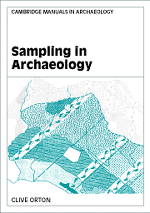Book contents
- Frontmatter
- Contents
- List of illustrations
- List of tables
- Acknowledgements
- 1 All the world's a sample
- 2 A little of what you fancy?
- 3 If this is the sample, what was the population?
- 4 Covering the ground
- 5 What's in a site?
- 6 The answer lies in the soil
- 7 ‘But many sanguine people hope, to see them through a microscope’
- 8 ‘In its depths, what treasures’
- 9 Beyond random sampling
- Appendix
- Bibliography
- Index
8 - ‘In its depths, what treasures’
Published online by Cambridge University Press: 05 June 2012
- Frontmatter
- Contents
- List of illustrations
- List of tables
- Acknowledgements
- 1 All the world's a sample
- 2 A little of what you fancy?
- 3 If this is the sample, what was the population?
- 4 Covering the ground
- 5 What's in a site?
- 6 The answer lies in the soil
- 7 ‘But many sanguine people hope, to see them through a microscope’
- 8 ‘In its depths, what treasures’
- 9 Beyond random sampling
- Appendix
- Bibliography
- Index
Summary
Introduction
Having looked at sampling at a wide range of scales, from the regional to the microscopic, we now turn to our final topic – the sampling of objects from museum stores. This may seem to be an unusual topic for a book on archaeology, but there are several good reasons for including it:
(a) since the museum store is the ultimate destination of most archaeological finds, we as archaeologists have a legitimate interest in their care there;
(b) the museum store makes an excellent vehicle for demonstrating some of the approaches described in chapter 2;
(c) the application of some approaches is particularly clear here, since some of the problems typically associated with sampling in the field may be avoided;
(d) techniques have been developed for repeated sampling (p. 201), which have potential for use at other scales, but have not yet been applied there;
(e) I have had a long personal involvement and interest in this topic.
Historical background
In the UK, statistical interest in the care of museum collections was stimulated by the publication of a report from the National Audit Office (1987–8), although of course the care of collections has always been a recognised duty of museums. The first survey intended to establish the overall condition of an entire collection seems to have been one undertaken by the Horniman Museum (London) in the late 1980s (Walker and Bacon 1987).
- Type
- Chapter
- Information
- Sampling in Archaeology , pp. 191 - 205Publisher: Cambridge University PressPrint publication year: 2000



